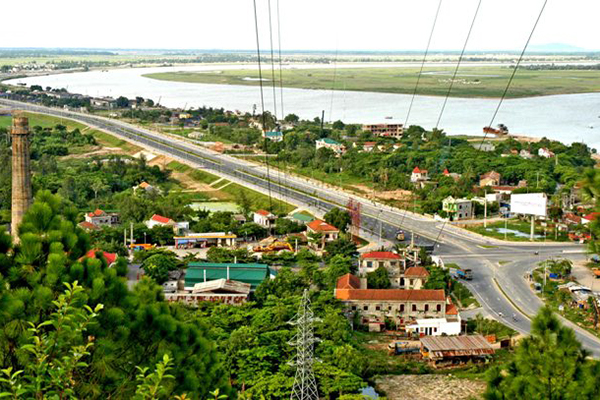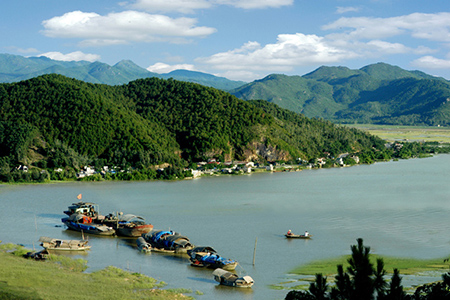Nghe is abbreviation of Nghe An, and Tinh one of Ha Tinh. These two provinces often merge under the name of Nghe Tinh. This frontier region of ancient Vietnam, which covered only the northern part of present-day Vietnam, was for a long time disputed land involving Vietnam and Champa. It was limited in the south by the Transverse Pass (Deo Ngang).
Nghe Tinh, also called Nghe Country (Xu Nghe), has an area of over 22,000 square kilometres and a population of three million. For people of ancient Vietnam it was a far-away land with a savage and mysterious beauty. A folksong said: The way to Nghe country presents twists and turns Green mountains and blue waters: a real painting!

Mount Hong Linh and the river Lam (523 kilometres) are its emblems. A large part of the land lies under forests and the area devoted to rice growing is far from fertile. Agriculture is subject to the whims of a harsh climate; the scorching wind coming from neighbouring Laos in the west (gio Lao) carries with it dry heat which causes plants to wither.
Nghe country is full of memorable spots. The king who founded the second Viet state (Au Lac) in the 3rd century BC, An Duong Vuong, is venerated at a temple in Dien Chau. Mai Hac De (8th century), the prestigious leader of a revolt against the Chinese occupier, is worshipped at Nam Dan, where he established a resistance base. In 1788, the glorious Nguyen Hue. who later mounted the throne with the regal title of Quang Trung, came from the south at the head of an army of peasant insurgents. In Nghe Tinh, 90,000 men joined him for an offensive on Thang Long (Hanoi) which routed the Chinese Qing army occupation. The King wished to build a new capital at Mount Quyet near Vinh, but the project could not be concluded. In the course of contemporary history Nghe country witnessed many episodes of the patristic struggle: the scholars’ movement led by Phan Dinh Phung “to save the King” (Can Vuong) the Nghe Tinh Soviets (1930), the Do Luong mutiny (1941) – all savagely repressed by the French colonial administration; the Americans dropped on the region 3.000 lonnes of bomhs and razed to the ground the industrial city of Vinh.
The first settlers in Nghe Tinh were soldiers, exiles, adventurers. The continual population movements and the repeated struggle against a harsh nature and hostile neighbours give the people distinctive traits: Nghe Tinh men have a reputation of being resilient and tough, courageous, hard-working and intelligent, but also very stingy. There is a story about a Nghe Tinh man who is so tight-fisted that at meals served to him at an inn he would have nothing to accompany his rice but a wooden fish taken out of his own haversack, which he would dip in a little fish sauce and lick. Hence the nickname given to Nghe Tinh men of ca go (wooden fish).
Nghe Tinh scholars are reputed for their love of study. In the time of triennial competitions Quynh Doi village atone accounted for 94 doctors of humanities and 152 licentiates of humanities. A record number, for selection was so tightly conducted that many a village could not boats a single doctor, even a single licentiate.
Nghe country has its sentimental side. The love songs of weavers’ guilds (hat phuong vai) are exquisite.
Last but not least, Nghe Tinh is the cradle of some of the most illustrious people of the nation: poets like Nguyen Du, author of the immortal Tale of Kieu, Nguyen Cong Tru, Ho Xuan Huong – historians like Su By Nhan, physicians like Le Huu Trac (alias Hai Thuong Lan Ong), thinkers like Nguyen Thiep (La Son Phu Tu), scholar patriots like Phan Dinh Phung. Revolutionaries like Ho Chi Minh…

